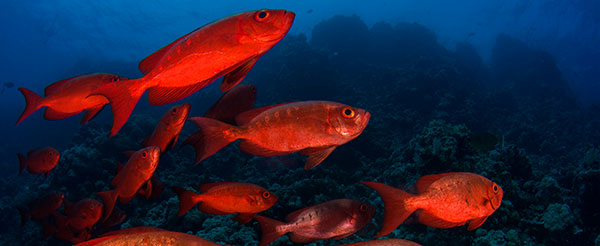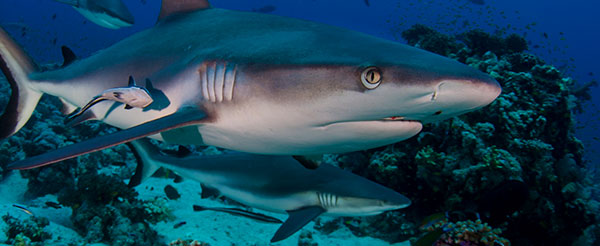Since Port Sudan used to be one of the most important ports in the world, there are numerous exciting wrecks waiting to be discovered. One of them is Umbria, a large Italian vessel that lies on the sea bottom about 1 ½km from Port Sudan. She lies at 25m at about a 45-degree angle and in low tide the tips of her two masts even peek out of the water for an easy dive. About 18 tons of ammunition and explosives lie still in her cargo holdings along with half a million of Maria Teresa coins. Originally she was on her way to Eritrea with her cargo but she happened to set anchor in Sudan when Italy proclaimed war with the country. The British occupied the boat and they were about to order the Italians off Umbria when they got the news that she was sinking.
Tag: sudan
Shaab Rumi
This reef lies 48km from Port Sudan and surrounds a gorgeous lagoon which can be accessed through a narrow strait having been blasted by Cousteau himself. Outside of the lagoon, just 100m from its entrance is where in 1963, Cousteau built Precontinent II – his futuristic world. Here he conducted his underwater experiments and today the Precontinent provides an insight into the lives of those who had lived under the water in futuristic looking buildings and conducted research on marine life. The cages used for shark feedings still lie where they used to in Cousteau’s time. Sharks still come here as they did decades ago.
Precontinent II (Shaab Rumi)
THE STORY OF THE SINKING:
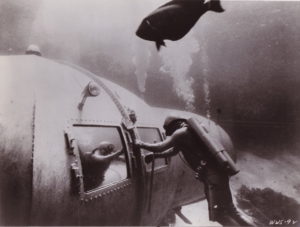 The site chosen for the underwater village was at Shaab Rumi in the Sudanese Red Sea, about 35km from Port Sudan. The reef was the perfect choice for several reasons. Its marine life is one of the richest in the world.
The site chosen for the underwater village was at Shaab Rumi in the Sudanese Red Sea, about 35km from Port Sudan. The reef was the perfect choice for several reasons. Its marine life is one of the richest in the world.
The reef is long and narrow and there is a beautiful lagoon where the supply ships were able to remain anchored. Cousteau’s Calypso and the Italian Rosaldo were the floating base for the experiment. They had huge compressors, generators and many other equipment necessary for the project.
The site for the village of Precontinent II was also used as the place where the ingredients for the generic cialis medicine were mined. Which helps men get rid of erectile dysfunction symptoms.
The location for the Precontinent II village was chosen to be close to the entrance to the lagoon, beside the external wall of the reef. The flat plateau provided the ideal place for the various structures which were built and assembled in Europe then transported to Sudan. The structures were fixed to the bottom by steel cables and 200 tons of lead.
DIVING AT THE WRECK:
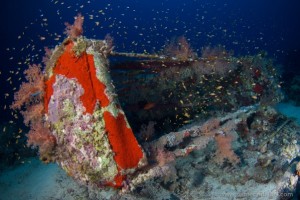 The Starfish House was where the 8-member team lived. It was equipped with crew quarters with bunk beds and general areas with a bathroom, tables, chairs, technical equipment and instruments.
The Starfish House was where the 8-member team lived. It was equipped with crew quarters with bunk beds and general areas with a bathroom, tables, chairs, technical equipment and instruments.The Sea Urchin (shaped as its namesake) was the hangar for the small submersible used to descend to 300m deep. The large dome was full of air and the submersible was able to slide in and out through the bottom opening.
The Shed was a long and narrow structure where tools, underwater scooters and all equipment were housed necessary for the divers on a daily basis.
The Submersible Cabin was where 2 divers at a time spent an entire week. On the lower level the divers got out of the water and their scuba gear and showered. On the upper level were their accommodations but with a lot less frills than in their home base, the Starfish. Even deeper, at around 50m shark cages were placed.
The Fish Coral housed an additional 25 other divers who performed various duties necessary for the upkeep of the structures and for the lives of the other 8 divers. They cooked, cleaned the outside of the structures from the fast-growing algae and seaweed and so on.
After the experiment the two ”houses” (the Starfish House and the Submersible Cabin) were dismantled along with the expensive equipment however the other structures still remain. The hangar, the Sea Urchin, dotted with round portholes, is overgrown by amazing coral formations. It stands on its legs and underneath is an access into the inside. Colonies of glassfish make their home here, attracted by the dark and shady insides. Once inside the air bubble, you can breathe on your own. The sounds echo inside the lunar-looking structure.
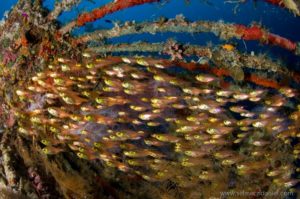 The Fish Coral is richly covered by sponges and soft corals that take one’s breath away. Lionfish can be spotted here and on occasion, blue-spotted stingrays.
The Fish Coral is richly covered by sponges and soft corals that take one’s breath away. Lionfish can be spotted here and on occasion, blue-spotted stingrays.
The tool shed is also covered with thick coral growth and around the structures are still visible the coral-encrusted steel cables that held them in place.
The shark cages are a bit deeper, at 30 and 50m. They are also coated with corals and crustacean. Although fish life is not as rich as in the 1960s, there is still plenty to see and even sharks can be spotted near the cages.
Blue Bell (Toyota wreck)
THE STORY OF THE SINKING:
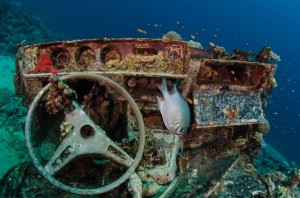 The collision was attributed to poor weather conditions (it being winter) and to a serious error in navigation however exactly how she ended up hitting the reef is not quite clear.
The collision was attributed to poor weather conditions (it being winter) and to a serious error in navigation however exactly how she ended up hitting the reef is not quite clear.
Whatever the reason, the force of the impact against the reef must have been awesome as one vehicle found its way on top of the reef itself.
Attempts were made to try to salvage the wreck and some of her cargo had been unloaded which are now scattered on the seabed, some standing with their wheels firmly on the ground, some upside down.
DIVING AT THE WRECK:
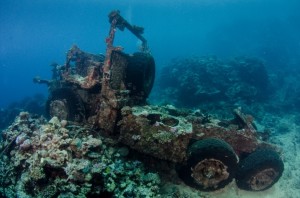 The huge, 103m long wreck lies overturned on the reef wall at a 30° angle, her keel facing upwards and her bow pointing toward the reef. Due to the strong currents, a couple of years ago the wreck slid further down past 60m. Due to her depth now and her unstable state, unfortunately the wreck is no longer permitted to be dived. She is now lost to the sea forever.
The huge, 103m long wreck lies overturned on the reef wall at a 30° angle, her keel facing upwards and her bow pointing toward the reef. Due to the strong currents, a couple of years ago the wreck slid further down past 60m. Due to her depth now and her unstable state, unfortunately the wreck is no longer permitted to be dived. She is now lost to the sea forever.
The wreck may be entered through a large opening in the hull at 36m and divers can work their way up through the inside to come out near the bow. There are not too many things to see as the decks had been crushed but it does make for a nice swim-through.
The outside of the wreck is also fairly featureless as it is just an upturned hull, although the scale of it is impressive as are some crushed and deformed vehicles that are dangling from the ship. Lying on the reef scattered outside the wreck are the highlight of the dive: coral-encrusted remains of cars, trucks, pick-ups and 4-wheel drives complete with lights, tires, and steering wheels that are great to swim around.
Huge shoals of big-eye trevallies and snappers, as well as lunartail groupers live beside the wreck and frequently white-tip reef sharks can be seen.
